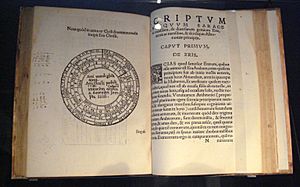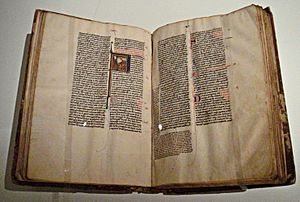Latin translations of the 12th century facts for kids
During the 12th century, European scholars really wanted to find new knowledge. They looked for books and ideas that weren't available in Western Europe at the time. This big search led them to places like central Spain and Sicily. These areas had recently come under Christian rule, but they had been controlled by Muslims for a long time. Because of this, many people there still spoke Arabic.
These regions were exciting places for learning. They had a lot of knowledge gathered over time and many Arabic-speaking scholars. This made them perfect for Latin scholars to visit and learn from. A famous example is Gerard of Cremona (who lived from about 1114 to 1187). He went to Toledo, a city in Spain, even after Christians took it back in 1085. He went because he loved a book called the Almagest, which he couldn't find in Latin. In Toledo, he saw many Arabic books on all kinds of subjects. He felt sad that Latin scholars didn't have access to this knowledge. So, he decided to learn Arabic to translate these important works.
For many centuries before this, ancient Greek ideas were mostly forgotten in Western Europe. Only a few monasteries had Greek books, and even fewer copied them. There was a short time when some Greek ideas came back during the Carolingian Renaissance. But after Charlemagne died, intellectual life slowed down again. By the 12th century, a new way of thinking called scholasticism began to grow. This led to the creation of universities across Europe. These universities collected the few Greek ideas that had survived. They also became places where new ideas from Arabic translations were discussed.
By the 12th century, several important cities had changed hands. Toledo was taken from Arab control in 1085, Sicily in 1091, and Jerusalem in 1099. Sicily, which still had many Greek speakers, was good for translations. However, Sicilians mostly translated directly from Greek to Latin. Spain, on the other hand, was perfect for translating from Arabic to Latin. This was because Latin and Arab cultures lived side by side there.
Unlike the later Renaissance which focused on old literature and history, 12th-century translators looked for new scientific and philosophical texts. They were also interested in translating some religious texts, like Greek Church Fathers and Jewish teachings from Hebrew. They even translated parts of the Qur'an and other Islamic religious texts. Some Arabic literature was also translated into Latin.
Contents
Translators in Italy and Sicily
Before the main period of translations in the 12th century, a Christian named Constantine the African translated medical books from Arabic. He was from Carthage and studied medicine in Egypt. He later became a monk in Italy. Constantine translated many important medical works. These included a medical encyclopedia by Ali ibn Abbas al-Majusi called The Complete Book of the Medical Art. He also translated ancient medical texts by Hippocrates and Galen that Arabic doctors had updated.
Sicily had a mix of cultures. It was part of the Byzantine Empire, then under Muslim control, and finally under Norman rule. Because of this, the Norman Kingdom of Sicily used three languages in its government. This made it a great place for translations. Sicily also had connections with the Greek East, which helped in sharing ideas and old manuscripts.
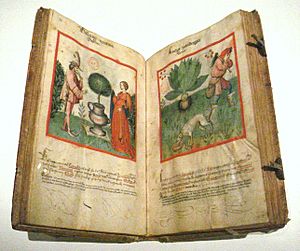
A copy of Ptolemy's Almagest, a major astronomy book, was brought to Sicily. Henry Aristippus translated some of Plato's works. An unknown student in Sicily translated the Almagest and works by Euclid from Greek to Latin. Even though Sicilians usually translated from Greek, they would use Arabic texts if Greek ones weren't available. Admiral Eugene of Sicily translated Ptolemy's Optics, using his knowledge of three languages.
Other important translations in Italy included Avicenna's The Canon of Medicine and al-Razi's Almansor. Fibonacci introduced the Hindu–Arabic numeral system to Europe in his book Liber Abaci (1202), based on Arabic sources.
James of Venice translated Aristotle's Posterior Analytics from Greek into Latin in the mid-12th century. This made Aristotle's complete logical works, known as the Organon, available in Latin for the first time.
In the 13th century, scholars in Italy continued to translate medical works. For example, Bonacosa translated Averroes' medical book Kitab al-Kulliyyat. Faraj ben Salem translated Rhazes' al-Hawi and Ibn Butlan's Tacuinum sanitatis.
Translators in Spain
Even before the 12th century, European scholars traveled to Spain to study. One famous scholar was Gerbert of Aurillac (who later became Pope Sylvester II). He studied mathematics near Barcelona. However, major translation efforts in Spain didn't start until after 1085. This was when Toledo was taken back by Christians. Early translators in Spain focused mostly on scientific works. This included mathematics and astronomy. They also showed interest in the Qur'an and other Islamic texts. Spanish libraries had many scholarly works written in Arabic. So, translators worked almost entirely from Arabic, often with the help of local Arabic speakers.
A very important translation project was supported by Peter the Venerable. He was the abbot of Cluny. In 1142, he asked Robert of Ketton, Herman of Carinthia, Peter of Poitiers, and a Muslim scholar named "Mohammed" to create the first Latin translation of the Qur'an. This translation was called the Lex Mahumet pseudoprophete.
Translations happened all over Spain and southern France. Important centers included Catalonia, Languedoc, Aragon, Navarre, and Segovia. The most important place for translations was the great cathedral library in Toledo.
Plato of Tivoli translated al-Battani's astronomy and trigonometry book. Robert of Chester translated al-Khwarizmi's Algebra and his astronomy tables.
The Toledo School of Translators
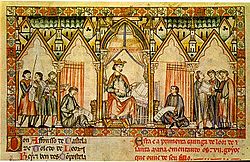
Toledo was a key learning center because it had many Arabic-speaking Christians called Mozarabs. Scholars from other parts of Europe came here to study subjects not easily found elsewhere. Early translators in Toledo included Avendauth and Domingo Gundisalvo. They worked together to translate Avicenna's encyclopedia, the Kitāb al-Shifa.
While people often talk about a "school of translation" in Toledo, it wasn't a formal school. It was more like a place where many translators gathered because the city was very open to their work. This made Toledo a practical and appealing place for them. As a result, many translators became active there, and Toledo became the main hub for translation.
However, translation efforts became more organized after Christians took Toledo in 1085. Raymond of Toledo, the Archbishop, started translation projects at the Cathedral of Toledo library. He led a team of translators. This team included Mozarabic Toledans, Jewish scholars, teachers, and monks. They translated many works from Arabic into Castilian, from Castilian into Latin, or directly from Arabic into Latin or Greek. They also made important texts from Arabic and Hebrew philosophers available. The Archbishop believed these texts were important for understanding Aristotle. Because of their work, the cathedral became a famous translation center. It was known as the Escuela de Traductores de Toledo (Toledo School of Translators). Its scale and importance were unmatched in Western culture.
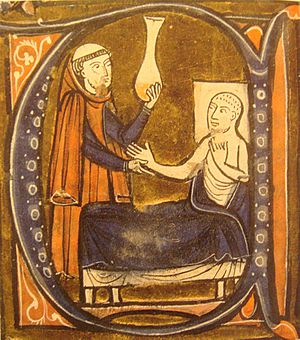
The most active translator in Toledo at that time was Gerard of Cremona. He translated 87 books! These included Ptolemy's Almagest and many works by Aristotle. He translated Aristotle's Posterior Analytics, Physics, On the Heavens and the World, and Meteorology. Gerard also translated al-Khwarizmi's On Algebra and Almucabala. Other translations included Archimedes' On the Measurement of the Circle and Euclid's Elements of Geometry. He also translated medical and chemical works by al-Razi (Rhazes) and Avicenna's The Canon of Medicine.
Later, under King Alfonso X of Castile, Toledo became even more important for translations. The King made sure that the translated books were "easy to understand." This helped them reach a much wider audience across Spain and other European countries. Many scholars from places like Italy, Germany, and England moved to Toledo to translate texts. They then took this new knowledge back to their home countries. The King even hired translators from many places with high salaries.
Michael Scot (who lived from about 1175 to 1232) translated works by al-Betrugi and Averroes' important comments on Aristotle's scientific works.
Later Translators and Works
Later translators continued this important work. Arnaldus de Villa Nova (1235–1313) translated works by Galen and Avicenna. In Portugal, Giles of Santarém translated works by Rhazes and Mesue.
William of Moerbeke (about 1215–1286) was a very busy medieval translator. He translated many philosophical, medical, and scientific texts from Greek into Latin. He was asked to translate all of Aristotle's works or improve existing translations. This was because earlier Latin copies of Aristotle, which came from Spain, were thought to be influenced by Averroes. Averroes was suspected of adding philosophical and religious errors. William's translations were very accurate and became standard classics. For some of his translations, the original Greek texts have since disappeared. This means without him, those works would be lost forever. William also translated math books by Hero of Alexandria and Archimedes.
Other European Translators
Adelard of Bath (active 1116–1142) translated al-Khwarizmi's astronomy and trigonometry work. He also translated his arithmetic book and Abu Ma'shar's Introduction to Astrology. Adelard also translated Euclid's Elements. He worked with other scholars in England who translated and developed astronomical ideas from Spain.
Other translators included Alfred of Sareshel, who translated works by Nicolaus of Damascus and Hunayn ibn Ishaq. Many scholars translated works by Avicenna, Averroes, Galen, and al-Razi. These translations covered a wide range of subjects, including medicine and science.
Many alchemical works were also translated. One of the first was the Liber de compositione alchemiae (Book of the Composition of Alchemy). This was translated by Robert of Chester in 1144. It included a conversation between Morienus and Khālid ibn Yazīd. Other important alchemical works attributed to Jabir ibn Hayyan (Geber) were also translated.
Translations into Hebrew
In the 12th century, in southern France and Italy, many Arabic scientific texts were translated into Hebrew. These areas had large Jewish communities who didn't know much Arabic. So, translating into Hebrew helped them access Arabic science. Sometimes, translators used Hebrew as an in-between step before translating from Arabic into Latin. This was common from the 13th to the 16th centuries.
Key Translations from Greek
Here are some important works that were translated from Greek into Latin after about 1100:
- Hippocrates (5th, 4th centuries B.C.):
* Aphorisms: Translated by Burgundio of Pisa in the 12th century. * Various medical books: Translated by Gerard of Cremona and others from Arabic in Toledo in the 12th century. * Various medical books: Translated by William of Moerbeke after 1260.
- Aristotle (384-322 B.C.):
* Posterior Analytics: Two versions from Greek in the 12th century; also from Arabic in Toledo in the 12th century. * Meteorologica (Book 4): Translated by Henricus Aristippus in Sicily around 1156. * Physica, De Generatione et Corruptione, Parva Naturalia, Metaphysica (first 4 books), De Anima: Translated from Greek in the 12th century. * Meteorologica (Books 1-3), Physica, De Cælo et Mundo, De Generatione et Corruptione: Translated by Gerard of Cremona from Arabic in Toledo in the 12th century. * De Animalibus (about animals): Translated by Michael Scot from an Arabic version in Spain around 1217-20. * Almost all works: New or revised translations by William of Moerbeke from Greek around 1260-71.
- Euclid (about 330-260 B.C.):
* Elements (15 books): Translated by Adelard of Bath from Arabic around 1126.
- Archimedes (287-212 B.C.):
* De Mensura Circuli: Translated by Gerard of Cremona from Arabic in Toledo in the 12th century. * De Iis quæ in Humido Vehuntur (On Floating Bodies): Translated by William of Moerbeke from Greek in 1269.
- Ptolemy (2nd century A.D.):
* Almagest: Translated from Greek in Sicily around 1160; also by Gerard of Cremona from Arabic in Toledo in 1175. * Optica: Translated by Eugenius of Palermo from Arabic around 1154.
- Proclus (412-485 A.D.):
* Elements of Theology: Translated by William of Moerbeke from Greek in 1268.
|
See also
 In Spanish: Traducciones latinas del siglo XII para niños
In Spanish: Traducciones latinas del siglo XII para niños
- Toledo School of Translators
- Renaissance of the 12th century
- Islamic world contributions to Medieval Europe
- Lex Mahumet pseudoprophete
- List of translators
- Graeco-Arabic translation movement


